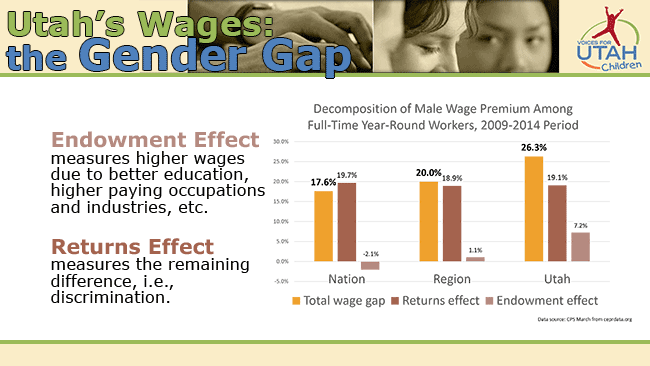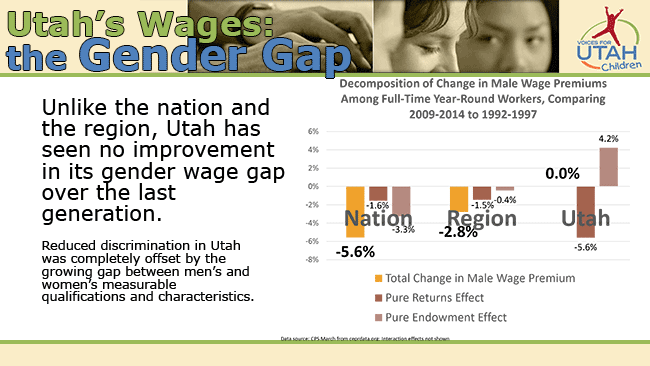Utah’s Gender Opportunity
In January 2015, Voices for Utah Children released Utah's Gender Opportunity: An examination of the difference between the earnings of Utah men and women. The report revealed that:
- Nationally, women earn $0.79 for every dollar earned by men. In Utah, the equivalent figure is $0.70.
- Utah has the 4th largest gender gap in the nation.
- Utah’s wage gap has been closing, but at one of the slowest rates in the country.
A new report, Explaining Utah's Gender Gap in Wages, addresses the questions:
- Why does Utah fare so poorly in terms of wage equity?
- What are possible solutions to improve Utah women’s economic status?
Why the Wage Gap Exists
We can think of the wage gap being the result of two factors:
- Women may tend to possess characteristics and qualifications that lead to them being paid less on average (for example, less education than men, an unfavorable occupational distribution, less experience, more family responsibilities, etc.).
- Employers pay women less than men with similar qualifications (discrimination).
First, we quantify how much of the wage gap can be attributed to these two factors:
- How much of the wage gap is due to observed and measurable differences between average attributes – qualifications and characteristics – of men and women (the “endowment effect”)?
- The remainder of the wage gap would be due to variables not measured or controlled for in our regression, including discrimination (the “returns effect”).
Wage Gap Decomposition
Utah has a larger total wage gap than the nation or the Intermountain region, with men earning 26.3% more than women, compared to 20% for the region and 17.6% for the nation. Using the Oaxaca-Blinder decomposition, we break down the total wage gap into the returns and endowment effects.
- In Utah, the endowment effect result shows men earn 7.2% more than women because of men’s measured characteristics relative to women; on average, men are more educated, have higher paying occupations, and work in higher paying industries.
- Utah’s returns effect result shows that the remaining difference (19.1%) is due to men and women being paid differently for the same qualifications and characteristics due to discrimination as well as any other factors that our regression did not account for.
Conclusion: Thus, the returns effect, which is intended to measure discrimination, explains the vast majority of the gender wage gap in Utah, in the Intermountain region, and nationally.
However, as we will see, this is only part of the story.
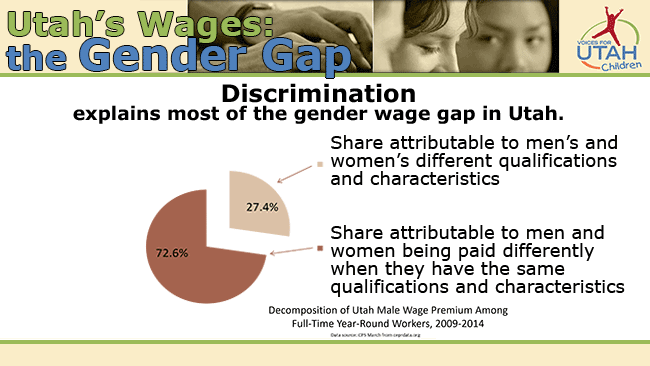
Breaking Down Utah’s Endowment Effect
This chart shows a breakdown of Utah’s endowment effect.
- In Utah, measurable differences between men and women in level of education, occupational choices, and industrial distribution make the wage gap larger.
- At the national and regional levels, industrial composition serves to make the wage gap larger, while education and occupational choice make the wage gap smaller.
In other words, education and occupational choice work in the opposite direction in Utah compared to the national or regional levels.

Why Is Utah Different?
Why does Utah have a larger wage gap than the nation or Utah’s neighbors?
Just as we decomposed the wage gaps, we can also decompose the difference between the wage gaps (Utah vs. its neighbors and Utah vs. the nation) into:
- A part we can attribute exclusively to differences in qualifications and measured attributes (“pure endowment effect”).
- A part we can attribute exclusively to differences in how men and women are paid (“pure returns effect” which is the part that includes discrimination).
- Interaction terms (omitted on the graph because they are small and not interesting on their own).
Decomposition of Wage Gap Differences
- Utah has a larger wage gap than either the nation or Utah’s neighbors.
- Utah has a larger wage gap mainly because of the endowment effect.
- Utah women are more disadvantaged due to education, occupation, and industrial distribution in Utah compared to women at the regional and national levels.
- The differences in the returns effect, which seeks to measure discrimination, do not appear to be statistically significant between Utah and the nation or between Utah and the Intermountain region.
Conclusion: Thus, while the returns effect, which is intended to measure discrimination, explains most of Utah’s gender wage gap, the endowment effect explains most of why Utah’s gap is so much worse than the nation’s.
Differences between men’s and women’s qualifications and characteristics explain over 90% of the difference between Utah’s wage gap and that of the nation.
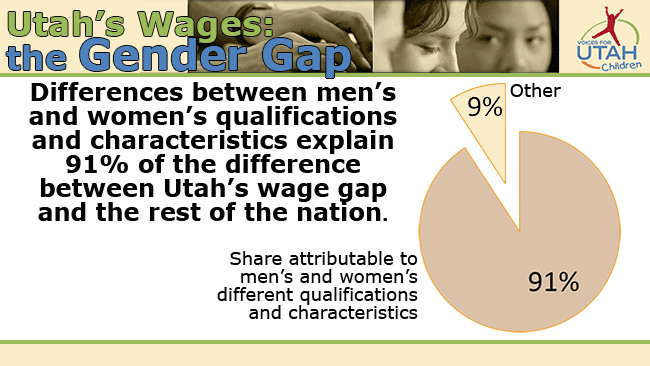
How Utah’s Gap Has Changed Over Time
We would like to know how Utah’s gap now compares to what it was a generation ago (2009-2014 vs. 1992-1997). We can separate the change into:
- A part we can attribute exclusively to changes in men’s and women’s measurable qualifications and characteristics (“pure endowment effect”.
- A part we can attribute exclusively to changes in how men and women are paid when their measurable qualifications and characteristics are equal (“pure returns effect”).
- Interaction terms (omitted on the graph because they are small and not interesting on their own).
Decomposition of Wage Gap Change Over Time
Here, negative numbers indicate an improvement in the wage gap over time.
Unlike the nation and the region, Utah has seen no improvement in its gender wage gap over the last generation.
- Utah has seen significant improvement in the returns effect over the past generation, more so than at the national and regional levels, indicating a diminishment in gender wage discrimination.
- However, that improvement in Utah was completely offset by the growing gap between men’s and women’s measurable qualifications and characteristics.
An Example:
How Men’s and Women’s Measurable Qualifications Have Changed Differently Over the Last Generation
United States vs. Utah, among full-time/year-round working men and women
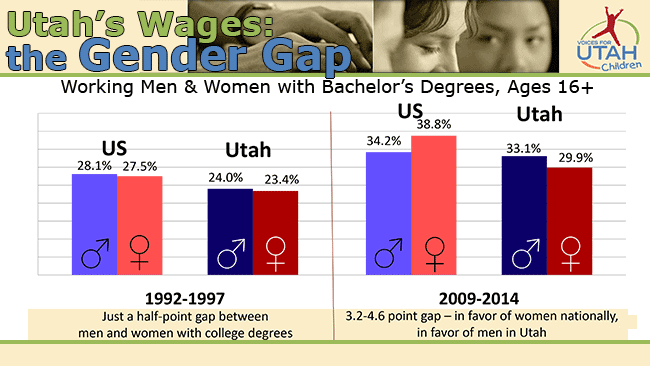
Policy Recommendations
- Pursue policies that seek to end direct wage discrimination.
- Investigate methods to improve women’s educational attainment and occupational and industrial distribution.
- Address workplace and other practices and policies that have a disparate impact on women by making it more difficult to balance work or education with family responsibilities.
- Pursue policies such as the Earned Income Tax Credit (EITC) that increase take-home pay at the lower wage levels, since women make up the majority of lower-wage workers.
Printer-friendly Report:
Explaining Utah's Gender Gap in Wages
The complete thesis which informed this report is available here: Explaining Utah's Gender Gap in Wages, Honors Thesis by Curtis Miller
The January 2015 report quantifying Utah's gender gap is available here: Utah's Gender Opportunity: An examination of the difference between the earnings of Utah men and women
For 30 years now, Voices for Utah Children has called on our state, federal and local leaders to put children’s needs first. But the work is not done. The children of 30 years ago now have children of their own. Too many of these children are growing up in poverty, without access to healthcare or quality educational opportunities.
How can you be involved?
Make a tax-deductible donation to Voices for Utah Children—or join our Network with a monthly donation of $20 or more. Network membership includes complimentary admission to Network events with food, socializing, and opportunity to meet child advocacy experts. And don't forget to join our listserv to stay informed!
We look forward to the future of Voices for Utah Children and we hope you will be a part of our next 30 years.
Special thanks to American Express for sponsoring our 30th Anniversary Year. 

